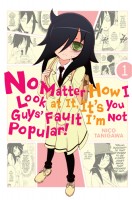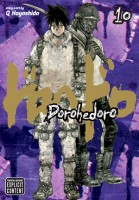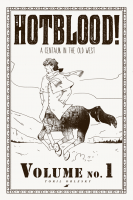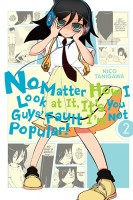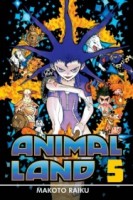My News and Reviews
Last week was a slower week at Experiments in Manga, but I am steadily coming to terms with the fact that I’m leading an increasingly busy life and that it’s okay to have slow blogging weeks. (Though I still wish I had the time to read and write more.) Anyway, last week I announced the Devils and Realist Giveaway Winner. The post also includes a list of some of the manga available in English that feature demons and devils. I also reviewed Project Itoh’s debut novel Genocidal Organ which is an excellent, intelligent work of near future science fiction. I’ve now read almost everything of Itoh’s that has been translated (I still need to pick up his Metal Gear Solid novel) which makes me a little sad since it’s all so good and I want more.
New York Comic Con was last week and there were some exciting license announcements to come out of that. Kodansha Comics will be releasing an Attack on Titan anthology collecting Western creator’s takes on the franchise (considering some of the artists and writers involved, this should be great) and has licensed Hounori’s Spoof on Titan and Hiroki Katsumata’s I Am Space Dandy. Viz Media announced a slew of new print titles: Mitsu Izumi’s 7th Garden, Yūki Tabata’s Black Clover, Izumi Miyazono’s Everyone’s Getting Married, Haruichi Furudate’s Haikyu!!, Tadatoshi Fujimaki’s Kuroko’s Basketball, Keiichi Hikami and Shin Yamamoto’s Monster Hunter, and Mizuho Kusanagi’s Yona of the Dawn. (I was very happy to see more sports manga and josei in that mix!) And Yen Press will be releasing Mikoto Yamaguchi’s Scumbag Loser, Makoto Kedōin and Toshimi Shinomiya’s Corpse Party: Blood Covered, Masafumi Harada, Sung-woo Park, and Red Ice’s Space Dandy, Yuji Iwahara’s Dimension W, and Cotoji’s Unhappy Go Lucky! as well as several new light novels.
Unrelated to NYCC (but still very interesting), manga-translator and yokai expert Zack Davisson was a guest on That Girl with the Curls podcast talking about all sort of things Japan-related. Actually, Davisson has been making the podcast rounds and was recently interviewed at Kaijucast, too, which happens to be featuring yokai all this month. Also of note, Connie at Slightly Biased Manga has posted a nice introduction/guide to all the various Alice in the Country of manga and light novels for anyone who may be intimidated the sheer number of titles involved.
Quick Takes
 Devil Survivor, Volume 1by Satoru Matsuba. Shin Megami Tensei is a huge and popular franchise of video games spanning multiple series and spinoffs which has spawned numerous anime and manga adaptations. Matsuba’s Devil Survivor is one of those, based on a 2009 tactical RPG for the Nintendo DS system. I’m always a little wary of manga adaptations of video games but was still interested in Devil Survivor. Unfortunately, it’s painfully obvious that the manga originated from a game. Although the story has some great mystery and action elements, as well as religious cults, demons, and so on, the original game mechanics are blatant in the story, made even more obvious by the characters’ use of handheld consoles. I’m not completely writing off the Devil Survivor manga, but honestly, I was disappointed with the first volume. I’m hoping that in the future the series will focus more on the story and characters, which have some great potential, and develop into something that takes advantage of the manga medium and feels less like watching someone else play a video game.
Devil Survivor, Volume 1by Satoru Matsuba. Shin Megami Tensei is a huge and popular franchise of video games spanning multiple series and spinoffs which has spawned numerous anime and manga adaptations. Matsuba’s Devil Survivor is one of those, based on a 2009 tactical RPG for the Nintendo DS system. I’m always a little wary of manga adaptations of video games but was still interested in Devil Survivor. Unfortunately, it’s painfully obvious that the manga originated from a game. Although the story has some great mystery and action elements, as well as religious cults, demons, and so on, the original game mechanics are blatant in the story, made even more obvious by the characters’ use of handheld consoles. I’m not completely writing off the Devil Survivor manga, but honestly, I was disappointed with the first volume. I’m hoping that in the future the series will focus more on the story and characters, which have some great potential, and develop into something that takes advantage of the manga medium and feels less like watching someone else play a video game.
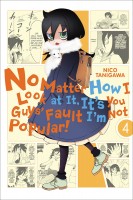 No Matter How I Look at It, It’s You Guys’ Fault I’m Not Popular!, Volumes 4-6 by Nico Tanigawa. In general Watamote tends to be fairly episodic, but time does slowly pass; the rhythm of school life drives the series along even if there isn’t much plot or character development per se. However, more and more recurring characters and running jokes are introduced and smaller story arcs form. The basic premise of Watamote is unchanging—Tomoko is an extremely awkward young woman whose social skills (or really the lack thereof) are entirely informed by the video games and manga that she’s interested in, many of which are rather raunchy. Occasionally she makes an effort to fit in with her classmates, but more often than not it backfires in terribly embarrassing ways. Watamote can be very funny in a painful and incredibly crass sort of way. Some but not all of the humor requires the reader to be at least vaguely familiar with Japanese pop culture, especially anime, manga, and video games. But there are copious translation notes available and the manga is usually fairly successful in conveying the basic gist of any given joke.
No Matter How I Look at It, It’s You Guys’ Fault I’m Not Popular!, Volumes 4-6 by Nico Tanigawa. In general Watamote tends to be fairly episodic, but time does slowly pass; the rhythm of school life drives the series along even if there isn’t much plot or character development per se. However, more and more recurring characters and running jokes are introduced and smaller story arcs form. The basic premise of Watamote is unchanging—Tomoko is an extremely awkward young woman whose social skills (or really the lack thereof) are entirely informed by the video games and manga that she’s interested in, many of which are rather raunchy. Occasionally she makes an effort to fit in with her classmates, but more often than not it backfires in terribly embarrassing ways. Watamote can be very funny in a painful and incredibly crass sort of way. Some but not all of the humor requires the reader to be at least vaguely familiar with Japanese pop culture, especially anime, manga, and video games. But there are copious translation notes available and the manga is usually fairly successful in conveying the basic gist of any given joke.
 The Sky Over My Spectacles by Mio Tennohji. I will readily admit that I have a thing for glasses; in addition to having to wear them myself, I really like how they look on other people. One of the leads in titular story of The Sky Over My Spectacles has a similar fetish, which is what initially drew the collection of boys’ love manga to my attention. (The Sky Over My Spectacles was actually one of the first boys’ love manga that I ever read.) The four main manga collected in the volume—”The Sky Over My Spectacles,” “Let’s Fall in Love,” “Let’s Meet at 1 p.m.,” and “Tell Me You Love Me with Earnest Eyes”—all tend to be fairly upbeat and even surprisingly cute and sweet. Although there’s a bit of drama to be found, nothing ends in tragedy, which I appreciate. I also enjoy the light sense of humor present throughout the stories in the collection. The titular, and longest, manga is probably my favorite, though. In it, Azuma, whose glasses fetish is infamous, has developed a crush on one of his male, glasses-wearing classmates but then discovers that his feelings remain unchanged even when the glasses come off.
The Sky Over My Spectacles by Mio Tennohji. I will readily admit that I have a thing for glasses; in addition to having to wear them myself, I really like how they look on other people. One of the leads in titular story of The Sky Over My Spectacles has a similar fetish, which is what initially drew the collection of boys’ love manga to my attention. (The Sky Over My Spectacles was actually one of the first boys’ love manga that I ever read.) The four main manga collected in the volume—”The Sky Over My Spectacles,” “Let’s Fall in Love,” “Let’s Meet at 1 p.m.,” and “Tell Me You Love Me with Earnest Eyes”—all tend to be fairly upbeat and even surprisingly cute and sweet. Although there’s a bit of drama to be found, nothing ends in tragedy, which I appreciate. I also enjoy the light sense of humor present throughout the stories in the collection. The titular, and longest, manga is probably my favorite, though. In it, Azuma, whose glasses fetish is infamous, has developed a crush on one of his male, glasses-wearing classmates but then discovers that his feelings remain unchanged even when the glasses come off.

